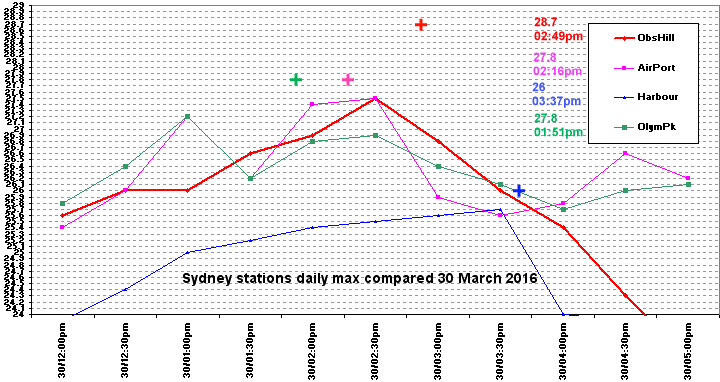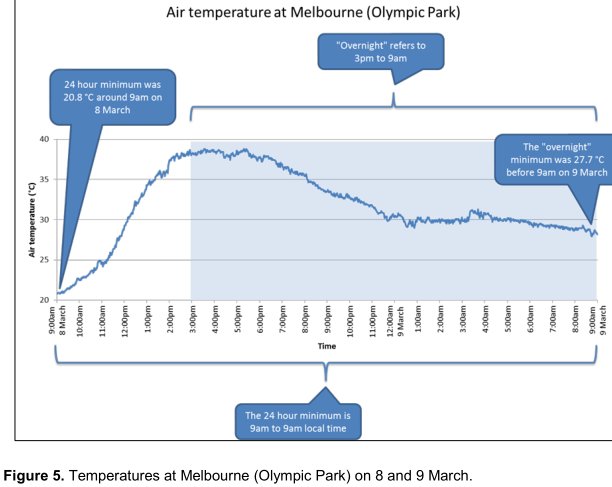The BoM thinks our Indian summer is important enough to rush out Special Climate Statement 55 – prolonged March heatwave affects many parts of Australia – I noticed Canberra mentioned in the table on page 15 and ran a few checks –
The BoM Time Series page (based on Acorn) shows that for NSW and SE Australia March 1940 had the hottest max but in their page 15 table the BoM are quoting successive days over 30 or 35 or whatever.
My chart shows the progression of the days for 1940 vs 2016 and we will see what can be said next month.

And of course we know that few stations have daily data digitised before 1957.
Another week like this and Aus/eastern Aus would be struggling to be the warmest.
www.bom.gov.au/jsp/awap/temp/index.jsp?colour=colour&time=latest&step=0&map=maxanom&period=week&area=nat
Agree Ian – will be re-assessing at months end.
The BoM is trying hard to make Sydney’s March max the hottest. Sydney Obs recorded a top temp of 28.7C at 2:49pm today (30 Mar).
At 2:30pm the temp was 27.5C and by 3:00pm it was down to 26.8C.
So up 1.2C in 29 mins and down 1.9C in 11 mins.
There was no such spike recorded for Sydney AP, Sydney Harbour or Sydney Olympic Park.
Sydney Obs had the top temp for all Sydney sites for the day, beating the next highest, Williamtown (28.4C).
See here at:
www.bom.gov.au/nsw/observations/sydney.shtml?ref=hdr
But you need to be quick.
Here is yesterdays max charted – you are right Ian the BoM found the tallest spike at Observation Hill. We will soon have the BoM full March data to try and assess how March 1940 rates now. Week ending 29th will not help much for a notably hot March –

Full-size copy of chart.
Tom Harley at Pindan Post has blogged on this issue at Broome where he says temperature spikes forming daily max are due to aircraft exhaust. jet-fueled temperature rises for Broome …
pindanpost.com/2016/03/26/jet-fueled-temperature-rises-for-broome/
Highest March max means for Sydney.
2006 27.1C
1998 27.0C
1940 26.9C
2015 26.8C
Present av max temp for Sydney to date – 26.8C.
Forecast for today 25C.
So should be 5th (or equal 5th with 1968).
Should be the warmest min temp for March on record and may have a slightly higher mean temp than 2006.
Will be checking for a spike today.
One of the records referred to in Special Climate Statement 55 (SCS55) is a record high March overnight minimum for Melbourne of 27.7 °C on 9 March 2016. This record temperature occurred just before 9:00 a.m. AEDT (Australian Eastern Daylight Time) or 8:00 a.m. AEST (Australian Eastern Standard Time). The fact is, except for a few years during WW1 and WW2 daylight saving wasn’t introduced in Victoria until 1971, prior to that time observations were based on AEST. Had the record high overnight minimum been measured in terms of AEST then the outcome would have been somewhat different, at 9:00 a.m. AEST (10:00 a.m. AEDT) temperature was observed to be 24.4 °C, hence the overnight minimum, had it been observed in accordance with the original methodology, could not have been higher than that value. So while the BoM is correct in claiming another “record”, at best it’s a record that can’t claim relevance when compared with overnight temperature records established prior to 1971, that’s assuming no such overnight high temperature records were established during the brief WW1 and WW2 daylight savings periods.
It may be relevant to note also that the previous record was measured at a different weather station i.e. Melbourne Regional Office which is just north of the CBD, this station was pensioned off a couple of years ago. The station where the new record was measured, Melbourne Olympic Park, is just to the south east of Melbourne CBD and I would question whether the brisk north westerly blowing at the time through the concrete canyons of the city, preheated by a very hot previous day, didn’t play a part in it?
A similar record was created in 2010 with an “equal” highest overnight minimum temperature of 31.6 °C recorded for Melbourne on 12 January 2010, claiming to have equaled the previous record high overnight minimum set on 1 February 1902. The Herald Sun of 13 January, 2010 carried an article “Heat blast keeps city slicked with sweat – RECORD BREAKER” by Aaron Langmaid. The article included a graph, here, showing temperature vs. time for part of 12 January. By similar reasoning as applies to the recent record referred above, the temperature in this instance is shown to continue to fall between the time the record was observed just before 9:00 a.m. AEDT and 10:00 a.m. AEDT (9:00 a.m. AEST). Again this appears to be a record that cannot be compared with overnight temperature records created in the pre daylight saving era.
I can’t help but wonder how many more of these “daylight saving” tainted records have been incorporated into the Melbourne overnight temperature record.
I guess it goes to show, if you look long enough and hard enough, there’s always a record or two to be found?
Bob,
Never actually considered that angle but you are right.
Where would you find overnight min records?
I was in Melbourne that night and I watched early morning temps dropping. I was then under the impression that the minimum temp might actually be higher than the maximum temp for that day. However, there was a small spike to 28.3 (or 28.5) around 9.00am.
I now realise that the min temp is taken from 9:00am to 9:00am and the min was posted as 20.8.
From Page 7 SCS55

Melbourne experienced a very hot night on 9 March, with an overnight minimum temperature (measured from 3 p.m. to 9 a.m.) of 27.7 °C. This is the highest overnight minimum temperature on record for Melbourne for March (previously 26.9 °C on 18 March 2008). However, the 24-hour minimum from 9 a.m. to 9 a.m. (which forms the basis of the Bureau’s main official records) was only 20.8 °C, well short of record levels, because that was the temperature at 9 a.m. the previous day (Figure 5).
From P 9 SCS55
Thanks Warwick (you can just see the little spike just prior to 9:00am).
Very interested in Bob’s comment re DLS time. Does BoM take that into account? i suppose it would be hard since it wouldn’t have had the instruments to record temps to the minute as AWS do today.
Sydney max mean in March came in at =4th and min mean the highest by 0.1C.
2006 seems to have the highest mean temp on record (27.1 and 19.6) compared to 2016 (26.8 and 19.7).
www.bom.gov.au/climate/current/month/nsw/sydney.shtml
Lets see how the rest of the country goes.
Ian George
April 1, 2016 at 8:21 am
Ian
I’m unsure where you can find BoM data on overnight temperatures. I suspect that for some stations it could once be found on the monthly climate statistics page (it isn’t there now).
The 9:00 a.m. cut-off for overnight observations may date from the time when manual observations for many stations were done at 9:00 a.m. and 3:00 p.m. Presumably one of the 9:00 a.m. observations would have been to read the overnight minimum on a minimum thermometer?
My concern is that the BoM doesn’t acknowledge in any way that the current method of overnight temperature observation during the daylight saving period is at odds with what was done during those same months in the past. For instance, no mention is made about this when BoM loudly trumpets a new overnight record, such as they did in 2010 claiming a new record high overnight temperature on 12 January 2010 exceeding a record set back on 1 February, 1902.
Makes a change I guess to simply ignoring inconvenient historic temperature data or simply “homogenizing and adjusting” it into line with their preferred narrative.
Bob,
I was wondering if there was any record for overnight minimum records i.e. 9:00pm – 9:00am rather than the 24 hr min temps which are noted in CDO/MCS page.
For instance, the overnight temp for 9th March in Melbourne was 27.9C but the min temp is recorded at 20.8C.
So March for Aus came in highest for minimum, 0.03C higher than 1986 for mean temp and 7th for max temps (a full degree below 1986).
Ian George
April 1, 2016 at 6:59 pm
Ian
My recollection is that the BoM data file of statistics for the site (csv) (from a link at – Monthly Climate Statistics for ‘MELBOURNE REGIONAL OFFICE’ [086071]) once showed maximum overnight minimum temperature records, it doesn’t currently. Its interesting to note that the csv Monthly Climate Statistics for Melbourne Regional Office states the commencement date for the station as 1908 and then goes on to quote data for years in the range 1855 to 2015? The commencement dates for two nearby stations referred to, Burnley and Kew are noted as 1893 and 1869 respectively.
So where was Melbourne’s equal record high overnight minimum temperature of 30.6° C actually measured back on 1 February 1902? It could perhaps have been Burnley or Kew, but no maximum and minimum temperatures are quoted for these?
Australian Weather News shows daily maximum and minimum temperatures for Melbourne Regional Office going back to 1855.
Slightly OT, whilst looking for possible alternative sources for pre 1908 weather data for Melbourne I came upon a couple of “interesting” documents:
* Melbourne’s highest temperature on record, 117°F (47.2°C), on Black Thursday, 6 February 1851—but is it valid?
* Victoria’s highest temperature on record, 123.5°F (50.8°C), at Mildura, on 6 January 1906—but is it valid?
Thanks, Bob. Must check out AWN more closely.
I also have read about Mildura and Melbourne’s highest temps but both have been ‘dismissed’. Mildura because it was claimed the PO’s thermometer was reading too high and the temp didn’t ‘correlate’ with Deniliquin.
The Melbourne record of 1851 was never an ‘official’ temp but was not recognised due to another nearby site’s lower recording. It may have been also affected by the huge bush fires at the time (nearly a quarter of Vic was on fire) and the resultant hot northerlies – which, by the way, bush fires would have also affected the official record of 46.4 in Feb 2009.
I know Cloncurry’s temp in 1889 of 53.1C has now been discredited but it was listed in a BoM Publication , ‘The Wonders of the Weather’ (Bob Crowder) published in 1995 and again in 2000 on P98 (this page also includes the Mildura record).
However, it still must have been very hot not to warrant some recognition.
At least Oodnadatta’s record in 1960 still stands.
Tom Harley is raising this issue –
jet-fueled temperature rises for Broome …
pindanpost.com/2016/03/26/jet-fueled-temperature-rises-for-broome/
I mentioned that I thought BoM official temperatures were from 10 second readings – not so apparently – this BoM page says 1 second –
Observation of air temperature
www.bom.gov.au/climate/cdo/about/airtemp-measure.shtml
so the max and min we get these days would be more extreme than 25 years ago read from a mercury in glass thermometer.